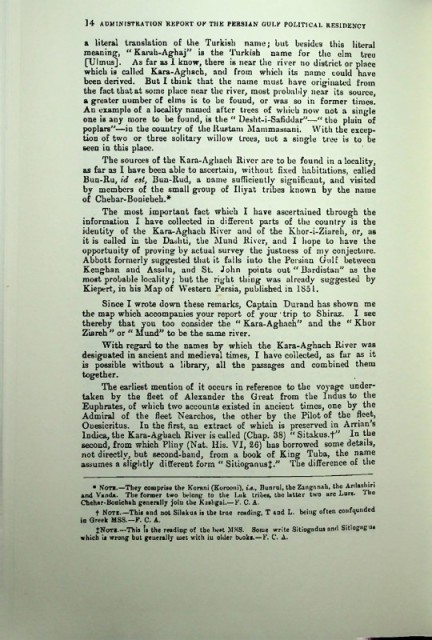Page 380 - PERSIAN GULF ADMINISTRATION REPORTS V1
P. 380
14 ADMINISTRATION REPORT OP THE PERSIAN GULF POLITICAL RESIDENCY
a literal translation of the Turkish name; but besides this literal
meaning, " Karah-Aghaj” is the Turkish name for the elm treo
[Ulmus]. As far as 1 know, there is near the river no district or place
which is called Kara-Aghach, and from which its name could have
been derived. But I think that the name must have originated from
the fact that at some place near the river, most probably near its source,
a greater number of elms is to be fouud, or was so in former times.
An example of a locality named after trees of which now not a single
one is any more to be found, is the “ Desht-i-Safiddar"—" the plain of
poplars"—iu the country of the Rustam Mammassani. With the excep
tion of two or three solitary willow trees, not a single tree is to be
6een in this place.
The sources of the Kara-Aghach River are to be found in a locality,
as far as I have been able to ascertain, without fixed habitations, called
Bun-Ru, id est, Bun-Rud, a name sufficiently significant, and visited
by members of the small group of Iliyat tribes known by the name
of Chehar-Bonicheli.*
The most important fact which I have ascertained through the
information I have collected in different parts of the country is the
identity of the Kara-Aghach River and of the Kbor-i-Ziareh, or, as
it is called in the Dashti, the Mund River, and I hope to have the
opportunity of proving by actual survey the justness of my conjecture.
Abbott formerly suggested that it falls into the Persian Gulf between
Kenghan and Assalu, and St. John points out “ Bardistan" as the
most probable locality; but the right thing was already suggested by
Kiepert, in his Map of Western Persia, published in 1851.
Since I wrote down these remarks, Captain Durand has shown me
the map which accompanies your report of your’trip to Shiraz. I see
thereby that you too consider the “ Kara-Aghach7' and the “ Khor
Ziareh " or “ Mund" to be the same river.
With regard to the names by which the Kara-Aghach River was
designated in ancient and medieval times, I have collected, as far as it
is possible without a library, all the passages and combined them
together.
The earliest mention of it occurs in reference to the voyage under
taken by the fleet of Alexander the Great from the Indus to the
Euphrates, of which two accounts existed in ancient times, one by the
Admiral of the fleet Nearchos, the other by the Pilot of the fleet,
Ouesicritus. In the first, an extract of which is preserved in Arrian's
Indica, the Kara-Aghach River is culled (Chap. 38) “ Sitakus.f" In the
second, from which Pliny (Nat. His. VI, 26) has borrowed some details,
not directly, but second-hand, from a book of King Tuba, the name
assumes a slightly different form “ SitioganusJ." The difference of the
• Note.—They comprise the Korani (Korooni), Bunrui, the Zangnnah, the Ardaslun
and Vanda. The former two belong to the Lnk tribes, the latter two are Lurs. I he
Chehar-Bonichah generally joiu the Kushgai.— F. C. A.
f Note.—This and not Silakus is the true reading, T and L. being often confounded
in Greek MSS.—F. C. A.
JNotb.—This Is the reading of tbe best MSS. Some write Sitiogndus and Sitiogagus
which is wrong but geuerally met with iu older books. — F. C. A.

